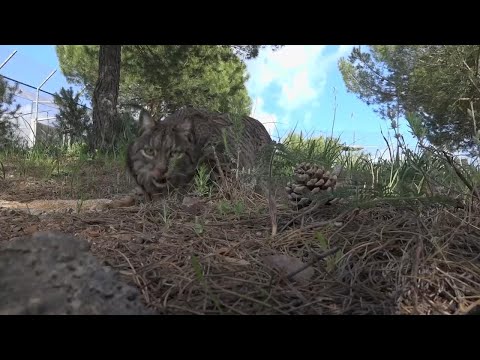(20 Jun 2024)
++EMBARGOED: 09:00GMT, THURSDAY 20 JUNE (20/06/24)++
SPAIN LYNX
SOURCE: ASSOCIATED PRESS
RESTRICTION SUMMARY:
LENGTH: 3:16
ASSOCIATED PRESS
ARCHIVE: Vilches, Jaen, Andalusia, Spain – 27 March 2018
1. Close of cage being opened and lynx exits and starts running
2. Wide of lynx running into the wild
3. Wide people pointing to horizon as they watch lynx move away
4. Wide of area where lynx was released
ASSOCIATED PRESS
Cambridge, UK – 19 June 2024
5. SOUNDBITE (English) Craig Hilton-Taylor, Head of Red List Unit, International Union of Conservation of Nature (IUCN):
++VIDEO CALL++
"So, the Iberian lynx has gone through a long period of decline, very closely linked to the decline in European rabbits. The rabbits are the main prey species for Iberian lynx, but also human activities in its habitat in Spain and Portugal. And the numbers went down, down, down until in 2001, they were only about 62 animals left, and so we had to list the species as critically endangered on the Red List. So, really bad news, but that then spurred a whole lot of action on the ground."
ASSOCIATED PRESS
ARCHIVE: Santa Elena, Jaen, Andalusia, Spain – 27 March 2018
6. Lynx inside breeding facilities hunting rabbit
ASSOCIATED PRESS
Cambridge, UK – 19 June 2024
7. SOUNDBITE (English) Craig Hilton-Taylor, Head of Red List Unit, International Union of Conservation of Nature (IUCN):
++VIDEO CALL++
"They set up conservation breeding programs. They set up lots of work to try and improve the habitats of the species, improve the mosaics, and the landscapes they live in. They also looked at how to address the issues with the declining rabbits and how do they get the rabbit populations back up again. And so, with all those efforts, it’s been really successful. So, we’ve had a steady rise in numbers over the years. So, in fact, it moved from, being critically endangered to endangered. And now, with tomorrow’s update, it moves to vulnerable. So, the numbers have gone up from 62 back in 2001, to 648 mature individuals in 2022. But in fact, the latest census figures you just had come into us from last year is that there are now more than 2,000 animals, Iberian lynx, adults and juveniles, in the wild in Spain and Portugal. It’s a really huge success, an exponential increase in the population size."
ASSOCIATED PRESS
ARCHIVE: Santa Elena, Jaen, Andalusia, Spain – 27 March 2018
8. Lynx inside breeding facility
ASSOCIATED PRESS
Cambridge, UK – 19 June 2024
9. SOUNDBITE (English) Craig Hilton-Taylor, Head of Red List Unit, International Union of Conservation of Nature (IUCN):
++VIDEO CALL++
"The bad news stories, species moving towards extinction, far outweigh the number of recoveries. So, it really shows that we need to do much, much more to improve the status of biodiversity if we’re going to meet the commitments under the global biodiversity framework that the world has signed up to."
ASSOCIATED PRESS
ARCHIVE: Santa Elena, Jaen, Andalusia, Spain – 27 March 2018
10. Close of lynx looking into camera
++EMBARGOED: 09:00GMT, THURSDAY 20 JUNE (20/06/24)++
STORYLINE:
++EMBARGOED: 09:00GMT, THURSDAY 20 JUNE (20/06/24)++
LEADIN:
Conservationists are celebrating the recovery of the Iberian lynx, no longer classed as "endangered" by the International Union of Conservation of Nature (IUCN).
Experts say numbers of Iberian lynxes – which call Spain’s Iberian Peninsula home – fell to as low as 62 mature individuals in 2001.
But now, thanks to successful breeding and reintroduction programs, the total population is estimated to be more than 2,000.
Find out more about AP Archive: http://www.aparchive.com/HowWeWork
Twitter: https://twitter.com/AP_Archive
Facebook: https://www.facebook.com/APArchives
Instagram: https://www.instagram.com/APNews/
You can license this story through AP Archive: http://www.aparchive.com/metadata/youtube/f7e742a25a814abe844d1ad063a024bd






